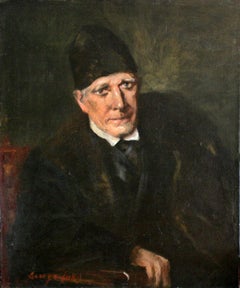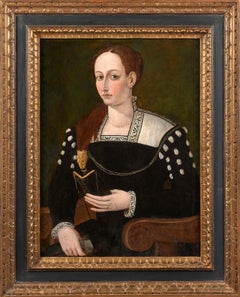George Luks Figurative Paintings
American, 1867-1933
George Luks was an American realist painter and comic illustrator, best known for his images of New York City and its inhabitants. Born in Williamsport, Pennsylvania, Luks worked as a vaudeville performer before moving to Philadelphia to study art at the Pennsylvania Academy of the Fine Arts. He traveled through Europe, where he attended several art schools and developed a particular admiration for Diego Velázquez, Frans Hals, and Édouard Manet. Even before leaving for Europe, Luks was publishing comic illustrations in Puck and Truth, and upon his return in 1893 he accepted a job as a newspaper illustrator at the Philadelphia Press. In 1896, the Press sent him to Cuba as a special correspondent to cover the mounting tensions there. Working at the Press, Luks befriended Everett Shinn, William Glackens, John Sloan, and Robert Henri.
In 1896 Luks moved to New York City and began to work as an illustrator for Joseph Pulitzer's New York World. He drew the comic strip Hogan's Alley after the strip’s originator Frederick Opper was lured away to William Randolph Hearst’s New York Journal. Though capable of picturesque urban scenes (like those that his friends Shinn and Glackens specialized in), Luks excelled as a broad comic artist, drawing single and multi-panel cartoons for newspapers and magazines, and working as a political cartoonist for the magazine Verdict. In the 1920s, Luks drew comic sketches for Vanity Fair and The New Yorker.
As a painter, Luks found inspiration in New York City, often depicting the streets and denizens of the Lower East Side, subjects which gained him little favor with art critics and jurors steeped in the genteel tradition. He painted thickly, often laying his paint on the canvas with a palette knife. In 1907, the rejection of one of his canvasses from a juried exhibition at the National Academy of Design spurred the organization of a protest exhibition the following year at Macbeth Gallery. This watershed exhibition would become known as the exhibition of "The Eight" for the eight painters who collaborated to put it together. Known for his big personality and love of liquor, Luks was a vocal proponent of American painting in the early 20th century.to
1
1
Overall Width
to
Overall Height
to
1
1
1
1
1
1
1
1
1
4
468
322
258
227
1
Artist: George Luks
Portrait of an Old Man
By George Luks
Located in Miami, FL
Painted from life with bravura brush strokes, Luks captures the essence of the sitter. Work is unframed.
Category
Early 1900s George Luks Figurative Paintings
Materials
Oil
$38,400 Sale Price
20% Off
Related Items
Italian 18th Century Oval Religious Oil on Canvas Painting with Saint Dominic
By Francesco de Mura
Located in Firenze, IT
This beautiful Italian 18th Century old masters oil painting on oval canvas with giltwood frame is attributed to Solimena and features a religious scene.
In this splendid oval-shaped painting are depicted Saint Dominic...
Category
18th Century Old Masters George Luks Figurative Paintings
Materials
Canvas, Oil
$13,062
H 21.66 in Dm 15.75 in
Portrait of a woman with a book
Located in BELEYMAS, FR
Italian school circa 1560, circle of Bernardino Campi
Portrait of a woman with a book
Oil on panel
H. 78 cm ; L. 57cm
Category
16th Century Italian School George Luks Figurative Paintings
Materials
Oil, Wood Panel
Portrait of baron de Roisin - Gendarmerie general
Located in BELEYMAS, FR
Flemish school of the 19th century
Armorial portrait of Baron Henri de ROISIN (1787-1846)
in the uniform of a general of the gendarmerie (1835)
Oil on canvas
H. 108 cm; W. 90 cm
Bar...
Category
1830s French School George Luks Figurative Paintings
Materials
Canvas, Oil
Portrait of young man - The artist's son
Located in BELEYMAS, FR
Auguste-Joseph Delécluse
(Roubaix 1855 - Paris 1928)
Portrait of the artist's son, Eugène Delécluse
Oil on canvas
H. 98 cm; W. 116 cm
Signed lower right
1903
Exhibition: 1903, Salon...
Category
Early 1900s French School George Luks Figurative Paintings
Materials
Canvas, Oil
Venus and Cupid
Located in BELEYMAS, FR
Hendrick Bloemaert
(Utrecht 1601/02 – Utrecht 1672)
Venus and Cupid
Oil on panel
H. 75 cm; W. 61 cm
Signed and dated 1636
Hendrick Bloemaert is a notable figure of the Golden Age of...
Category
1630s Flemish School George Luks Figurative Paintings
Materials
Oil, Wood Panel
Horse at the Blacksmith's
By Louis Henri Deluermoz
Located in BELEYMAS, FR
Henri DELUERMOZ
(Paris 1876 – Paris 1943)
At the blacksmith's
Oil on metal. Two welded plates
H. 145 cm; W. 100.5 cm
Signed lower left
Trained under Alcide-Joseph Lorentz and Charle...
Category
1890s French School George Luks Figurative Paintings
Materials
Metal
Holy family under an oak tree on a gold background
Located in BELEYMAS, FR
French school circa 1870
Holy Family under an oak, after Raphaël, on gold background
Oil on canvas
H. 92 cm; W. 60 cm
This aesthetic curiosity takes up the very famous composition b...
Category
19th Century French School George Luks Figurative Paintings
Materials
Canvas, Oil
Portrait of a Lady, After Sir Peter Lely (1610-1680) Oil Painting
By After Sir Peter Lely
Located in Uppingham, GB
Oil Painting After Sir Peter Lely (1610-1680) Portrait of a Lady
Housed in a Lely gold Leaf Frame.
Peter Lely:
In 1647 he became a member of the Pain...
Category
17th Century Old Masters George Luks Figurative Paintings
Materials
Oil
$16,759
H 57 in W 47 in D 4 in
Portrait of a man in armor
Located in BELEYMAS, FR
Attributed to Jacques DUMONT aka DUMONT LE ROMAIN
(Paris 1701 - 1781)
Presumed portrait of Louis-Joseph de Formanoir (?-1732)
Oil on canvas
H. 91.5 cm; L. 73 cm
Signed on the helmet:...
Category
1750s French School George Luks Figurative Paintings
Materials
Canvas, Oil
Portrait of Coraline - Belgian women
Located in BELEYMAS, FR
Auguste Adolphe CHAUVIN
(Liege, 1810 – Liege 1884)
Portrait of Coraline
Oil on canvas
Signed and dated lower right
91 x 68cm
1868
Auguste Adolphe Chauvin, born in Liège on October 2...
Category
1860s French School George Luks Figurative Paintings
Materials
Canvas, Oil
Neoclassical, renaissance, Biblical, St Sebastian "Martyrdom" (After Guido Reni)
By Giancarlo Impiglia
Located in Bridgehampton, NY
Part of Giancarlo Impiglia's iconic "camouflage" series in which, deviating from his signature style, he expresses his classical education, flawless technique, and concerns about the...
Category
2010s George Luks Figurative Paintings
Materials
Canvas, Oil
Presumed artist self-portrait
Located in BELEYMAS, FR
Louis-Gabriel BLANCHET
(Versailles, 1701 – Rome, 1772)
Presumed self-portrait of the artist
Oil on canvas
H. 73 cm; W. 60 cm
Circa 1730
Originally presented in a Restoration period frame with a "Mignard" cartouche, this beautiful painting initially appeared to us as a work from northern Italy. However, it exuded a rather French form of refinement, suggesting that its artist may have assimilated a dual influence from both sides of the Alps.
We thank our colleague and friend Philippe Mendès for spontaneously and judiciously "bringing out" the name of Louis-Gabriel Blanchet, a Romanized French portraitist, whose spirit and stylistic characteristics we clearly recognize here.
Blanchet's "French" years, before his final departure for Rome in 1728, following his winning of the second Grand Prix for painting after Subleyras in 1727, are extremely poorly documented. His father, Gabriel, was valet to Blouin, himself Louis XIV's first valet at the time. According to Thierry Lefrançois, Blanchet was one of the few students of Nicolas Bertin (1667-1736), whose studio he is said to have joined in the early 1720s. At a baptism on March 24, 1724, where he was godfather, he is mentioned as a painter in the picture store of the Duke of Antin, the director of buildings between 1708 and 1736. At this time, he was probably already married to Jeanne Quément, with whom he had a daughter also named Jeanne, who would marry Nicolas Aviet, the son of a valet in the queen's wardrobe, in Versailles in 1738.
When Blanchet arrived in Rome in October 1728, he was accompanied by Subleyras, Trémolières, and Slodtz. He enjoyed the goodwill of Vleughels, the director of the Académie de France, which had been based at the Palazzo Mancini since 1725, even though the latter was not always kind to our resident. From 1732, he was under the protection of the Duke of Saint-Aignan when he took up his post as ambassador to Rome. Along with Slodtz and Subleyras, they formed a trio of friends, joined by Joseph Vernet shortly after his arrival in Rome in 1734. Slodtz and Blanchet, on the occasion of Subleyras's marriage in 1739, were there to attest that their friend was not bound by any marital commitment, and Blanchet was a witness at Vernet's wedding in 1745.
It is most likely from these early years in Rome that our portrait of the artist dates, the expression and turn of his face irresistibly reminiscent of a self-portrait. The still relatively youthful features may correspond to Blanchet's thirty-something years, and the fluffy wig was still fashionable at this time.
The painting fits well with the depiction of a young painter wanting to display both the beginnings of success and a certain simplicity or restraint. A slight smile expresses a form of assurance in this man with a gentle, sincere gaze and a face radiating a keen sense of wit. We find here the air of intimacy present in almost all of Blanchet's portraits, even those from the 1750s and 1760s, as well as an almost complicity with the viewer. The spirit of the painting is quite close to that of the presumed portrait of Bouchardon (painted around 1730) and the portrait of Pannini, painted in 1736, but it possesses a more natural quality, notably thanks to the absence of decorum. Our work exhibits the characteristics of Blanchet's paintings: elegance, luminosity (especially in the whites), vibrant and refined colors (here, the harmony of the garnet of the garment and the slate blue of the background, whose uniformity is tempered by a very sketched landscape and a grove of greenery), light complexions, rather rosy cheekbones, often full lips, and rather tight framing.
According to the Academy's rules, Blanchet's stay should have ended in the spring of 1732, but, for reasons unknown, he remained in the Eternal City until his death, as did his friend Subleyras, with whom he shared accommodation until the late 1730s. The latter regularly called upon him to collaborate on his paintings, such as The Meal at Simon's. Through Saint-Aignan's intervention, Blanchet was employed in the late 1730s by the Stuart princely family, then exiled in Italy. He notably produced copies (now lost) after Liotard of the portraits of Charles Edward and Henry Benedict, the sons of James III Stuart. The latter also commissioned three other portraits (now in the National Portrait Gallery in London), whose more formal character contrasts with the intimate spirit of Blanchet's portraits. Blanchet frequented English painters, such as the landscape painter Richard Wilson, and studied with the Scottish portraitist Katherine Read...
Category
1730s French School George Luks Figurative Paintings
Materials
Oil, Canvas
George Luks figurative paintings for sale on 1stDibs.
Find a wide variety of authentic George Luks figurative paintings available for sale on 1stDibs. You can also browse by medium to find art by George Luks in oil paint, paint and more. Not every interior allows for large George Luks figurative paintings, so small editions measuring 26 inches across are available. Customers who are interested in this artist might also find the work of Frank Xavier Leyendecker, Gershon Benjamin, and Robert Riggs. George Luks figurative paintings prices can differ depending upon medium, time period and other attributes. On 1stDibs, the price for these items starts at $48,000 and tops out at $48,000, while the average work can sell for $48,000.

